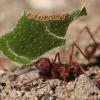Hi all!
So it did rain about 3 weeks ago I want to say, where I caught this ant with a male still attached to it. I placed it in a test tube set up, and about a day later, the male detached it self. I waited for it to die, but it never did. On day 4 or 5 the female detached her wings. Gave it another day, and used a q-tip to remove the male and wings. Fast forward to today, and I took this pic.
I suspect this is a Lasius species, however I am uncertain which exact one. She is small! (2mm or 3mm) Smaller than I expected a queen to be but after taking the photo, I understand a bit better. I am wondering if she will get bigger with time. I know she laid some eggs, but couldn't really tell what stage they were in until I snapped this shot too.

I plan on making some videos, and will post them too. Once I can confirm the species, Ill move this over to a Journal  (Would love a bit of help in the identification area if possible
(Would love a bit of help in the identification area if possible 
--..Archer.

























